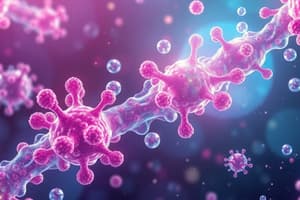Podcast
Questions and Answers
What is the role of bacteriostatic drugs in treating infections?
What is the role of bacteriostatic drugs in treating infections?
- They enhance bacterial growth.
- They prevent bacterial growth until the immune system eliminates the pathogen. (correct)
- They are equally effective for all types of infections.
- They kill bacteria immediately.
Why are bacteriostatic drugs not preferred in immunocompromised patients?
Why are bacteriostatic drugs not preferred in immunocompromised patients?
- They are ineffective against all bacterial infections.
- They prolong the infection by not killing the bacteria. (correct)
- They have a high rate of side effects.
- They are less potent than bactericidal drugs.
What is the primary role of normal flora in the gastrointestinal tract?
What is the primary role of normal flora in the gastrointestinal tract?
- Inhibiting all bacterial growth
- Maintaining pH and preventing colonization by pathogens (correct)
- Improving the absorption of all drugs
- Producing hormones for metabolic regulation
Which of the following defines the Minimum Inhibitory Concentration (MIC)?
Which of the following defines the Minimum Inhibitory Concentration (MIC)?
Which of the following describes the difference between bactericidal and bacteriostatic drugs?
Which of the following describes the difference between bactericidal and bacteriostatic drugs?
Which antibiotic class exhibits time-dependent killing?
Which antibiotic class exhibits time-dependent killing?
What does empiric antimicrobial therapy refer to?
What does empiric antimicrobial therapy refer to?
Which of the following statements about bactericidal drugs is true?
Which of the following statements about bactericidal drugs is true?
What is the primary advantage of using a single large dose of antibiotics over multiple daily doses?
What is the primary advantage of using a single large dose of antibiotics over multiple daily doses?
Which class of antibiotics is known to exhibit a long post-antibiotic effect (PAE)?
Which class of antibiotics is known to exhibit a long post-antibiotic effect (PAE)?
What is meant by the term 'minimum inhibitory concentration' (MIC)?
What is meant by the term 'minimum inhibitory concentration' (MIC)?
What does concentration-dependent killing refer to?
What does concentration-dependent killing refer to?
What is a key factor in determining appropriate dose schedules for antibiotics?
What is a key factor in determining appropriate dose schedules for antibiotics?
Which of the following is true regarding the postantibiotic effect (PAE)?
Which of the following is true regarding the postantibiotic effect (PAE)?
What mechanism is associated with Mycoplasma's resistance to penicillin?
What mechanism is associated with Mycoplasma's resistance to penicillin?
Which of the following best describes acquired antibiotic resistance?
Which of the following best describes acquired antibiotic resistance?
What is the purpose of susceptibility testing in antimicrobial therapy?
What is the purpose of susceptibility testing in antimicrobial therapy?
What happens during antibiotic-associated diarrhea with Clostridiodes difficile?
What happens during antibiotic-associated diarrhea with Clostridiodes difficile?
What describes the concept of antimicrobial prophylaxis?
What describes the concept of antimicrobial prophylaxis?
What does the term 'biofilm formation' refer to in the context of antibiotic resistance?
What does the term 'biofilm formation' refer to in the context of antibiotic resistance?
What is one reason for the rationale of using combinations of antimicrobial agents?
What is one reason for the rationale of using combinations of antimicrobial agents?
How can superinfection be defined?
How can superinfection be defined?
Why are aminoglycosides considered unsuitable for obligate anaerobes?
Why are aminoglycosides considered unsuitable for obligate anaerobes?
What effect do altered targets have on antibiotic resistance?
What effect do altered targets have on antibiotic resistance?
What is one of the main benefits of using synergistic drug combinations?
What is one of the main benefits of using synergistic drug combinations?
Which combination of drugs is known to cause antagonism?
Which combination of drugs is known to cause antagonism?
In which scenario would you use preemptive therapy?
In which scenario would you use preemptive therapy?
What typically causes superinfections during antibiotic treatment?
What typically causes superinfections during antibiotic treatment?
Which of the following strategies is effective in reducing the incidence of superinfections?
Which of the following strategies is effective in reducing the incidence of superinfections?
What is the main purpose of empirical therapy?
What is the main purpose of empirical therapy?
What characterizes prophylactic therapy?
What characterizes prophylactic therapy?
Which characteristic of broad-spectrum antibiotics increases the likelihood of superinfections?
Which characteristic of broad-spectrum antibiotics increases the likelihood of superinfections?
Study Notes
Learning Objectives
- Understand the significance of normal flora, particularly in the gastrointestinal tract.
- Differentiate between bactericidal and bacteriostatic drugs.
- Describe the pharmacokinetics of antimicrobial agents to guide dose scheduling.
- Explain the mechanisms of action of antibacterial drugs.
- Discuss the various resistance mechanisms to antibacterial drugs.
- Enumerate prophylactic uses of antibacterial therapy.
- Define superinfection and strategies to mitigate it.
High-Yield Terms
- Antimicrobial prophylaxis: Use of drugs to minimize infection risk.
- Combination antimicrobial therapy: Utilization of multiple drugs for enhanced efficacy.
- Empiric therapy: Treatment initiated before the identification of the specific pathogen.
- Minimum inhibitory concentration (MIC): Lowest concentration preventing visible growth after incubation.
- Postantibiotic effect (PAE): Continued suppression of microbial growth post-antibiotic concentration drop.
- Susceptibility testing: Laboratory assessment of pathogen sensitivity to antimicrobials.
Importance of Normal Flora
- Normal flora helps maintain gut pH and inhibits pathogenic organism colonization.
- It synthesizes essential vitamins like B and K.
- Misplacement of flora can lead to infections, especially in immunocompromised patients or when antibiotics disrupt balance (e.g., Clostridiodes difficile overgrowth).
Bacteriostatic vs. Bactericidal Drugs
- Bacteriostatic drugs: Inhibit growth; rely on host immune response; examples include azithromycin and sulfonamides.
- Bactericidal drugs: Kill bacteria; reduce viable organism counts; examples include rifampin, penicillins, and vancomycin.
Antibiotic Pharmacokinetics
- Influences dosage and scheduling for optimized therapeutic effects.
- Key pharmacokinetic indices include:
- Cmax/MIC: Maximum concentration ratio.
- T > MIC: Duration drug concentration exceeds MIC.
- AUC: Integral of drug concentration over time; relates to efficacy.
Killing Kinetics
- Time-dependent killing: Efficacy relies on drug concentration remaining above MIC (e.g., β-lactams).
- Concentration-dependent killing: More effective at higher concentrations (e.g., aminoglycosides).
Post-Antibiotic Effect (PAE)
- Describes prolonged antimicrobial effect despite falling drug levels.
- Notable for aminoglycosides and fluoroquinolones, facilitating once-daily dosing against Gram-negative bacteria.
Resistance to Antibiotics
- Natural resistance: Inherent resistance without prior exposure (e.g., Mycoplasma to penicillin).
- Acquired resistance: Developed resistance through mutation or selective pressure.
- Altered targets (e.g., MRSA).
- Decreased drug penetration (e.g., Gram-negative shields against β-lactams).
- Increased drug efflux and enzymatic inactivation (e.g., beta-lactamases).
Rationale for Drug Combinations
- Enhance efficacy and broaden antimicrobial coverage, especially in mixed infections.
- Synergistic effects may lower individual dosages and toxicities.
- Important for preventing resistance in chronic infections like tuberculosis and HIV.
Combinations to Avoid
- Avoid antagonistic combinations such as penicillin (bactericidal) with tetracycline (bacteriostatic), which can inhibit efficacy.
- Be cautious of drugs that induce beta-lactamases, disrupting disharmonious antibiotic actions.
Types of Antibacterial Treatment
- Prophylactic therapy: Preventive treatment in high-risk patients.
- Preemptive therapy: Active infection detection in asymptomatic individuals.
- Empirical therapy: Initial treatment based on symptoms, prior to specific lab results.
- Definitive treatment: Confirmed infection diagnosis with known pathogen sensitivity.
Superinfections
- Occur during antibiotic treatment due to disruption of normal flora, allowing opportunistic infections to thrive.
- Broad-spectrum antibiotics increase superinfection risk (e.g., Clostridium difficile).
- Key strategies to prevent superinfections include minimizing broad-spectrum antibiotic use and early infection detection and treatment.
Studying That Suits You
Use AI to generate personalized quizzes and flashcards to suit your learning preferences.
Related Documents
Description
This quiz covers the role of bacteriostatic drugs in treating infections, particularly in immunocompromised patients. It also explores the significance of normal flora in the gastrointestinal tract and delves into the concepts of Minimum Inhibitory Concentration (MIC) and the differences between bactericidal and bacteriostatic drugs. Test your knowledge on these important pharmacological concepts.




